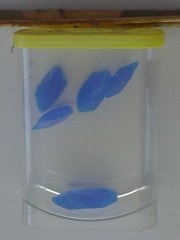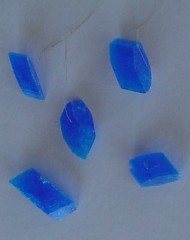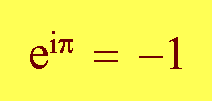
(
Copyright © 2012 by Mad Teddy
This page added Tuesday, 24th July 2012
A few days ago, I was going through some boxes of old stuff I hadn't looked
at for quite a while - and I found a small piece of yellow paper with a few
lines scrawled upon it by my own hand. I immediately realized that I had
stumbled upon a masterpiece which was far too good to be consigned to
oblivion.
Those few lines (five of them, actually) were a poem in limerick form.
Inspired, I made a few very minor modifications (to tighten up the metre,
basically, and thus make it
scan
properly), and added two more verses. The result is as you see below:
Now, the main point of diff'rence, you see
The fact of the matter withal
(Actually, if the truth be told, one of the corrections I made to the first
verse was to change "ichthyol'gist" to "malacol'gist". This was only after I
started to wonder whether the study of ichthyology covered molluscs - and
found, via a bit of careful Googling, that it doesn't! That particular field
of interest is known as "malacology". So I've learned something - and
perhaps you have too, if you didn't know that before either! Aren't we all
getting educated?
Anyway, having resurrected that first verse, I decided to have a bit of a
hunt around on the web to see what I could find out about squids,
cuttlefish, and related beasties. That's how verses 2 and 3 came into being.
One of the first web-pages I found had a quite neat animated gif featuring a
somewhat hyperactive-looking squid:
That page is
here,
if you'd like to have a look. Also, if you'd like to see a page containing
some good general information about squids, of course there's
this
Wikipedia page. (Note: that page contains some quite
surprising information!
I also found some quite interesting YouTube videos, one of which - about
flamboyant cuttlefish - appealed to me to the point where I decided to try
my hand at embedding it in this page (my first such attempt, in any of my
pages):
(There you go - now I know how to do it!
Cute little things, aren't they? Apparently the amazing rippling-stripes
routine is intended to warn potential predators that these creatures are
poisonous, and best left alone.
This
Wikipedia page provides a good description of how it "works".
On a similar theme, have a look at
this
page. Spooky...
While other related creatures may not have this facility, some of them
can change colour to blend in with their surroundings, thus
effectively becoming invisible, in an attempt to avoid becoming someone
else's next meal.
This
Royal Society
web-page goes into considerable detail about the "mechanics" of how these
colour-changing systems work. Also, can I ask you to keep an open mind while
you read
this
article, which puts a very interesting slant on the phenomenon?
As a means of summing this matter up,
this
YouTube video, which features the work of a researcher in the field,
presents some graphic detail as to how the effect is achieved, along with
some quite eye-popping examples. Well worth a look.
Here's
a page which features, amomg other things, a simple but effective cut-away
diagram of the anatomy of a cuttlefish, which goes a long way to explaining
how these quite confusing-looking creatures function - not only with regard
to the colour-changing phenomenon, but in other ways also (as well as
emphasizing the point that they are not fish). Finally, also on the specific
topic of cuttlefish,
here's
a short but interesting page which gives some detail about the cuttlebone,
as well as mentioning (among other things) the surprising fact that the
blood of these creatures is bluish-green, rather than red, because it
contains a
copper-containing protein
instead of the iron-containing
haemoglobin,
which we mammals use.
Of the four creatures mentioned in my nerdy little poem (above), the
nautilus is the only one that doesn't have any colour-changing ability.
However, they definitely do have other points of interest. Have a look at
this
Wikipedia page.
Quite fearsome-looking little brutes, aren't they?! (If you'd like to see a
BBC video clip of one in action, click
here.
You might also like to have a look at
this
YouTube video, which features quite a surprise about 40 seconds into
it!)
However, as a person interested in mathematics, I find that the most
interesting thing about the nautilus is its shell. As these creatures grow,
they build increasingly large compartments in which to live; the end result
is an attractive shell in the form of a good approximation to a logarithmic
(or equiangular) spiral. See the Wikipedia article about it
here.
(Note, in that page, a graphic showing part of the mathematical object known
as the Mandelbrot Set. I have several pages about the "M-set" within this
site; click
here
to see one of my pages which features a somewhat similar graphic to the one
on that Wikipedia page just mentioned.)
I haven't yet had much to say about the octopus, the last of the four
creatures mentioned in my poem. Read on.
Like the cuttlefish and the squid, the octopus has the ability to change
colour in order to camouflage itself. (From what I've read, it's only the
flamboyant cuttlefish that can (or wants to, perhaps?) do the
rippling-stripes effect; the squid and the octopus are less ostentatious, it
seems, preferring to settle for a simple "disappearing act" - along with
most "ordinary" cuttlefish.)
Here's
a short but spectacular YouTube video about how an octopus can blend into
its surroundings; and
here's
a link to the Wikipedia page about these slippery-looking creatures.
- - - - - - - - - -
Now, I know you're just busting for me to have something to say about
the 3.1415926535897932... bit in the penultimate line of the third and final
verse of my poem. (Aren't you...?) So here we go:
Of course, it's an approximation (to seventeen significant figures) to that
well known
transcendental
number known as "pi", which is the ratio of the length of the circumference
(C) of a circle to its diameter (d):
(In case you're really not familiar with this, or haven't thought about it
for a long time so that you've forgotten the details,
here's
a link to the excellent Wikipedia page about it - and lots of other
intriguing facts about pi also.) So - what's it doing in my poem?
Well, if you've just visited the Wikipedia "octopus" page (I presented the
link two paragraphs back), and read down toward the end, you'll know that
the plural of the word "octopus" is a vexed issue. (Rather than go into the
quite complex details here, may I instead implore you to visit that page and
read all about it, if you haven't already.) So: ever the nerd, I thought it
would be amusing to draw attention to the fact that the word "octopi" is at
least one aspect of the perceived problem by substituting the first
several digits of the decimal expansion of pi into the word. As
justification for doing so (i.e. deliberately using a technically-incorrect
plural for "octopus", as well as inserting some numerical representation
into the proceedings) - if any such justification is actually needed - I
suppose you could say that I'm indulging in a bit of
poetic license.
So now you know! (if you hadn't figured it out already).
(Incidentally, if you didn't click on that representation of pi within the
poem on your way here, may I urge you to do so now. If you're anything at
all like me, it will bring a smile to your face. If you'd like to read the
lyrics of the song while you listen to it - and perhaps sing along with them
yourself - you'll find them
here.
Also, please note that at
the end of this page, you'll find two graphics in which I've presented a
couple of the many known formulas which involve pi in some way; I find these
two particularly fascinating. Clicking on them will take you to further very
interesting web-pages on the subject. I just thought I'd better give you
prior warning - otherwise, when you get there, you may well find yourself
thinking: "Here we go again - what's nerdy old Teddy up to this
time?"
Go ahead - allow yourself to be caught up in the mystique of it all!)
To close off this page in a suitably offbeat manner, let's recapitulate a
bit. By way of setting the mood, I've decided to again present a graphic
from near the top of this page:
How would you describe our somewhat nervous-looking red friend? What's the
best adjective we might find in an attempt give a reasonably accurate
description of this
character's je ne sais quoi?
Does the word
"squidgy"
come to mind, perhaps...?
(To be even further disorientated, click
here
and
here...)
- - - - - - - - - -
I must have been about nine or ten years old when our family went to the
cinema one evening to see some major film or other. In those days (the early
1960's), generally there would be a series of short pieces on first -
perhaps including a cartoon, a newsreel, and an episode of Batman (these
used to terrify me!); then there'd be a short interval before the lights
went down again for the main feature, which would conclude the evening's
entertainment.
Well, I've no idea what the main feature was that night, or whether or not I
was freaked out by a particularly scary Batman episode on that occasion -
but there was one short film which stuck in my mind, just because it was
quirky, odd, and amusing (even, perhaps, just a bit disturbing). In fact,
it's stayed with me over this last half a century or so.
It was a sort of cartoon, with the pictures drawn somewhat roughly
on a white background. The whole thing was narrated by English comic actor
Kenneth Williams
(who had a very recognizable, highly characteristic "funny voice"; he was
was regularly featured in several comedy radio shows of the time, such as
"Hancock's Half-Hour", in addition to his appearances in many movies of
that era).
This film told the story of two quite different characters: one, a
disorganized fellow who couldn't do anything right, but whom everybody
loved; and the other, a very tidy and correct chap whom nobody liked. The
name of the first was Squidgy Bod (a-ha!), and the name of the
second was Thermus Fortitude.
(I won't give away any more details of the plot here, because I don't want
to spoil it for you. Suffice it to say that there was a moral at the
end...)
After our household first got onto the internet about fourteen years ago,
I occasionally hunted for any information about this strange, oddly
compelling little film. Occasionally, something might pop up - but rarely
enough to help me to track down much in the way of detail. All very
frustrating...
... Until (I think) about a year or so ago, when I found - to my huge
delight - that the film itself had appeared on YouTube! (How good is that?)
Thus, after all these intervening decades, I was again able to view this
remarkable little objet d'art.
So: without further ado,
here's
the direct YouTube link to
"Love Me, Love Me, Love Me"
by
Richard Williams,
and narrated by Kenneth Williams.
Or, if you'd like to see a discussion page about the film
with that YouTube link embedded within it, click
here.
(The link to the film itself is about halfway down the page.) Either way - enjoy!
UPDATE, Wednesday, 25th July 2012
The more I think about it, the more I think that the droll, somewhat dark
humour of "Love Me (×3)" is very similar to that of the Cream song
Pressed Rat and Warthog,
which appeared on the album
Wheels of Fire... In The Studio
just a few years later (1968). [Click
here
for a YouTube link, and
here
for another YouTube link which features (I believe) the only live
version of the song ever performed by the group -
correct me
if I'm wrong.] Good for a chuckle - and sort of in keeping with
the "wildlife" ethos of the poems in this part of my website!
UPDATE, Friday, 19th April 2013
Just last night, while idly browsing through a few YouTube videos, I found another one by Richard Williams - in some ways
reminiscent of "Love Me, Love Me, Love Me", with a somewhat similar ever-so-slightly cynical take on life. Entiltled "A
Lecture On Man", it was released in 1962 - around the same time as "Love Me...". Its style is somewhat similar to that of
some early Monty Python material which it perhaps foreshadowed. (It even borrows a bit of the music from "Love Me..."!)
Even though the sound quality is not great (perhaps due to the film's age), this is well worth a look, while we're in
vaguely satirical mode.
Here's
the link - enjoy!
Return to
sub-menu
My home page
Preliminaries (Copyright, Safety)
Awkward "Fishy" Poem
 a.k.a. "Squid Pro Quo"
a.k.a. "Squid Pro Quo"  )
)
(my first new web-page for the year - shame on me!)
The distinction 'tween fish which are cuttle
And the squid, may appear to be subtle;
But a malacol'gist
Will quite likely insist
That it's not, and thus give a rebuttal.
(Less well-known to folks like you and me),
Is that cuttles - not squid -
Have a
cuttlebone,
kid,
Which they use to adjust buoyancy.
(Which, with effort, you may well recall),
Is that like nautili,
And also octo3.1415926535897932...,
They're both molluscs - they're not fish at all!
I've no idea what inspired me to write that first verse, or when I wrote it.
Perhaps there had been a story on television about the final space shuttle
flight, and I was thinking: "I wonder what rhymes with..." - but I'm not
sure. So it will have to remain a mystery. Of such is life made up, thus
lending it its everlasting intrigue.
 )
)

 )
)
 Clever old me!)
Clever old me!)

 Many copper compounds are blue or bluish-green. 20 years ago, I grew some
high-quality
copper sulphate
crystals - still in good condition (bright blue) because I've kept them in
an airtight container in a cool place, so that they've retained their
water of crystallization.
(This
page introduces the topic of crystal-growing quite well.)
Many copper compounds are blue or bluish-green. 20 years ago, I grew some
high-quality
copper sulphate
crystals - still in good condition (bright blue) because I've kept them in
an airtight container in a cool place, so that they've retained their
water of crystallization.
(This
page introduces the topic of crystal-growing quite well.)












As promised above, these two "pi-graphics" are links to
other pages about this fascinating number. Be intrigued...


